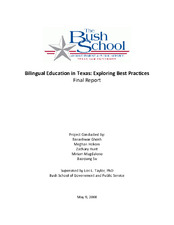| dc.contributor.advisor | Taylor, Lori L. | |
| dc.creator | Ghosh, Banashwar | |
| dc.creator | Hokom, Meghan | |
| dc.creator | Hunt, Zachary | |
| dc.creator | Magdaleno, Miriam | |
| dc.creator | Su, Baoqiang | |
| dc.date.accessioned | 2011-07-21T15:27:10Z | |
| dc.date.available | 2011-07-21T15:27:10Z | |
| dc.date.issued | 2008 | |
| dc.identifier.uri | https://hdl.handle.net/1969.1/97015 | |
| dc.description | This capstone team conducted an analysis of bilingual and English as a second language (ESL) practices in the state of Texas. Their analysis has three distinct parts. In the first part, the team developed four indicators of school success with respect to students who have limited English proficiency (LEP). In the second part, they developed a survey of teacher, classroom and program characteristics that they distributed to all elementary and middle schools with at least 30 LEP students. The final part of their analysis examined the relationship between their four measures of school success and the survey responses regarding instructional practices and program characteristics. The team found that there were no school-level differences in performance between teachers in bilingual education programs and teachers in ESL programs. They also found that consistent instruction in one language (either English or Spanish) was more effective for content learning than a mix of instructional languages, and that instructional methods identified as particularly effective by the existing bilingual/ESL literature are widely practiced in Texas. | en |
| dc.language.iso | en_US | |
| dc.title | Bilingual Education in Texas: Exploring Best Practices | en |
| dc.type | Other | en |
| dc.contributor.sponsor | Florence Shapiro, Chair, Senate Committee on Education | |



